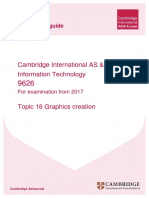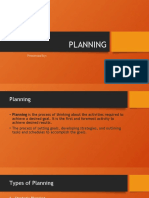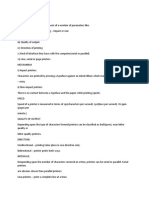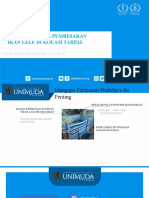1.3 Storage End of Unit Quiz Lesson Element
1.3 Storage End of Unit Quiz Lesson Element
Uploaded by
Shakila ShakiCopyright:
Available Formats
1.3 Storage End of Unit Quiz Lesson Element
1.3 Storage End of Unit Quiz Lesson Element
Uploaded by
Shakila ShakiOriginal Title
Copyright
Available Formats
Share this document
Did you find this document useful?
Is this content inappropriate?
Copyright:
Available Formats
1.3 Storage End of Unit Quiz Lesson Element
1.3 Storage End of Unit Quiz Lesson Element
Uploaded by
Shakila ShakiCopyright:
Available Formats
End of Unit Quiz – Unit 1.
3 Storage
1. What is secondary storage?
2. Why is secondary storage needed on a computer?
3. Secondary storage is often referred to by another name? What is it?
4. Data can be either externally or internally stored in secondary storage devices.
a. What is one external secondary storage device?
b. What is one internal secondary storage device?
5. Give three types of secondary storage and describe one advantage for each of their uses.
Version 1 1 © OCR 2017
6. A supermarket checkout uses a barcode reader to store and read items being scanned.
a. Which type of storage uses a barcode reader to store and read items being
scanned?
b. Why is this type of storage the most suitable?
7.
a. What are two advantages for using secondary storage?
b. What is one disadvantage for using secondary storage?
8. Which type of secondary storage is most suitable for distributing a movie?
9. Suggest a storage device that could be used for distributing a movie.
10. What secondary storage device could be used for distributing music tracks?
11. Give two reasons why a CD-ROM is suitable for distributing music.
Version 1 2 © OCR 2017
12. What is a secondary storage device that could be used for transferring text files from a
school computer to a PC at home?
13. What is one disadvantage of using magnetic tape to store data?
14. How many bytes are in 3MB of data? You must show your working out.
15. What are two factors that should be considered when deciding on how data is stored?
16. Fill in the table below by placing hard disk, DVD, CD against its most appropriate capacity.
Capacity Storage type
Up to 4.7Gb
Upto 800Mb
200Gb to 1Tb
Version 1 3 © OCR 2017
17. What is meant when describing the ‘capacity’ of a storage device?
18. What is meant when describing the ‘portability’ of a storage device?
19. What is meant when describing the ‘durability’ of a storage device?
20. What is meant when describing the ‘reliability’ of a storage device?
Version 1 4 © OCR 2017
Answers
1. What is secondary storage?
Where devices are not constantly connected to the computer.
Devices not directly accessible by the computer’s CPU.
2. Why is secondary storage needed on a computer?
Used to back up data stored in main memory/primary storage.
Stores programs/data and other files that would otherwise be lost when the power is
switched off/RAM is volatile/cannot store data permanently.
Need for larger storage capacity.
3. Secondary storage is often referred to by another name? What is it?
Auxiliary (storage).
4. Data can be either externally or internally stored in secondary storage devices.
a. What is one external secondary storage device?
CDs
Memory card
DVD
Blu-ray disc
Flash drive
USB memory stick
External hard disk drive
External solid state drive
b. What is one internal secondary storage device?
Hard disk drive (HDD)
Solid state drive (SSD)
5. Give three types of secondary storage and describe one advantage for each of their uses.
Optical
Inexpensive/reliable/robust/relatively large capacity
Magnetic
Store large capacity/commonly used making it possible to share compatibility/can be used
to store operating system and other files and programs/reliable/cost-effective
Solid state
Flexible/Inexpensive/faster access to data/Can be used for portable devices/generally
smaller in size/robust/easy to use/no setup requirements
Version 1 5 © OCR 2017
6. A supermarket checkout uses a barcode reader to store and read items being scanned.
a. Which type of storage uses a barcode reader to store and read items being
scanned?
Solid state.
b. Why is this type of storage the most suitable?
Fast access. Less delays when turning the device on.
Robust. Device can be moved/handled without it getting damaged.
Small/light. Fits in the barcode reader.
Uses less power to battery life.
7.
a. What are two advantages for using secondary storage?
Memory is non-volatile.
Data is not lost when the computer is switched off.
Stores larger amount of data.
b. What is one disadvantage for using secondary storage?
Data may not be current.
Device could get lost.
Need for a writer on the computer to write information to CD, DVD, Blu-ray discs.
8. Which type of secondary storage is most suitable for distributing a movie?
Optical.
9. Suggest a storage device that could be used for distributing a movie.
DVD.
10. What secondary storage device could be used for distributing music tracks?
CD.
11. Give two reasons why a CD-ROM is suitable for distributing music.
Cheap to produce.
Easily portable.
Enough capacity for the music tracks.
Can be read by other devices.
Read only/can’t be over written.
Version 1 6 © OCR 2017
12. What is a secondary storage device that could be used for transferring text files from a
school computer to a PC at home?
USB stick/pen/flash memory.
CD.
13. What is one disadvantage of using magnetic tape to store data?
Slow to write to and read from memory.
All data has to be read before reading the data you want.
Data could be corrupted if close enough to a magnetic field.
Additional equipment needed to read data from tape.
14. How many bytes are in 3MB of data? You must show your working out.
3 * 1 000 000
3 000 000/3m/3 million
15. What are two factors that should be considered when deciding on how data is stored?
Capacity
Speed
Portability
Durability
Reliability
Cost
16. Fill in the table below by placing hard disk, DVD, CD against its most appropriate capacity.
Capacity Storage type
Up to 4.7Gb DVD
Upto 800Mb CD
200Gb to 1Tb Hard disk
17. What is meant when describing the ‘capacity’ of a storage device?
Size of data/file.
18. What is meant when describing the ‘portability’ of a storage device?
Refers to whether the data needs to be moved from one device to another.
Version 1 7 © OCR 2017
19. What is meant when describing the ‘durability’ of a storage device?
Length of time expected for data to last.
20. What is meant when describing the ‘reliability’ of a storage device?
Refers to whether the data will be saved as expected.
Data is not effected when saved.
No changes to file formatting.
This formative assessment resource has been produced as part of our free GCSE teaching and learning support package. All the
GCSE teaching and learning resources, including delivery guides, topic exploration packs, lesson elements and more are available on
the qualification webpages.
If you are looking for examination practice materials, you can find Sample Assessment Materials (SAMs) on the qualification webpage:
Computer Science (9-1)
We’d like to know your view on the resources we produce. By clicking on ‘Like’ or ‘Dislike’ you can help us to ensure that our resources
work for you. When the email template pops up please add additional comments if you wish and then just click ‘Send’. Thank you.
Whether you already offer OCR qualifications, are new to OCR, or are considering switching from your current provider/awarding
organisation, you can request more information by completing the Expression of Interest form which can be found here:
www.ocr.org.uk/expression-of-interest
Looking for a resource? There is now a quick and easy search tool to help find free resources for your qualification:
www.ocr.org.uk/i-want-to/find-resources/
OCR Resources: the small print
OCR’s resources are provided to support the delivery of OCR qualifications, but in no way constitute an endorsed teaching method that is required by the Board, and the decision to
use them lies with the individual teacher. Whilst every effort is made to ensure the accuracy of the content, OCR cannot be held responsible for any errors or omissions within these
resources.
© OCR 2017 - This resource may be freely copied and distributed, as long as the OCR logo and this message remain intact and OCR is acknowledged as the originator of this work.
OCR acknowledges the use of the following content: n/a
Please get in touch if you want to discuss the accessibility of resources we offer to support delivery of our qualifications: resources.feedback@ocr.org.uk
Version 1 8 © OCR 2017
You might also like
- Ict Igcse Chapter 3 SummaryDocument6 pagesIct Igcse Chapter 3 SummaryEsra Taha100% (1)
- Igcse Ict 3ed TR Chapter 4Document10 pagesIgcse Ict 3ed TR Chapter 4sularekahNo ratings yet
- ICT Grade 7 UAEDocument85 pagesICT Grade 7 UAEfalasteen.qandeelNo ratings yet
- Study Pack Grade 7 ICTDocument6 pagesStudy Pack Grade 7 ICTmodcommataraNo ratings yet
- Computer Science Lesson Plan Week 3 - T3-PracticalDocument4 pagesComputer Science Lesson Plan Week 3 - T3-PracticalIshrat JehanNo ratings yet
- Year 8 KS3 Computer Science Homework BookletDocument14 pagesYear 8 KS3 Computer Science Homework Bookletsanchos86No ratings yet
- Limited Companies and MultinationalsDocument3 pagesLimited Companies and MultinationalsKazi Rafsan NoorNo ratings yet
- IGCSE ICT MCQ Mock 4Document6 pagesIGCSE ICT MCQ Mock 4rahimuddin0% (1)
- Worksheet 01, Yr 9, ICTDocument3 pagesWorksheet 01, Yr 9, ICTJK EduNotes100% (1)
- Project (Grade 7 - ICT)Document1 pageProject (Grade 7 - ICT)abdelkhalek hassaboNo ratings yet
- ICT Sample Paper 1 and 2Document74 pagesICT Sample Paper 1 and 2Minduli0% (1)
- IGCSE ICT Chapter 9, 12Document7 pagesIGCSE ICT Chapter 9, 12rahimuddinNo ratings yet
- Y7 Computing - Part2Document17 pagesY7 Computing - Part2hunia abbassNo ratings yet
- 3.design StageDocument3 pages3.design Stagekhalid loda0% (1)
- Flow Chart Practice - Grade 6Document6 pagesFlow Chart Practice - Grade 6Arwa Abu JbrahNo ratings yet
- Ict Chapter 3 NotesDocument6 pagesIct Chapter 3 Notesyumna zain0% (1)
- Cambridge Ict Starters Administrative Guide 2018 PDFDocument29 pagesCambridge Ict Starters Administrative Guide 2018 PDFParu SinghNo ratings yet
- By Rayyan Rmis Icct Igcse Workbook Practical AnswerDocument32 pagesBy Rayyan Rmis Icct Igcse Workbook Practical AnswerRayyan killer0357No ratings yet
- IGCSE Chapter 5 - The Effects of Using ICTDocument3 pagesIGCSE Chapter 5 - The Effects of Using ICTTrần Sỹ HoàngNo ratings yet
- Igcse WorkbookDocument8 pagesIgcse Workbookwafia yNo ratings yet
- Assignment 1Document7 pagesAssignment 1D BalendranNo ratings yet
- Information Technology Grade 10 ExamDocument2 pagesInformation Technology Grade 10 ExamDeon LatchmanNo ratings yet
- Comp 10ThDocument151 pagesComp 10ThTechnical ZainNo ratings yet
- Types and Components of A Computer SystemDocument10 pagesTypes and Components of A Computer SystemNeetika100% (1)
- Ict Rev Igcse 5791 C9.unlockedDocument11 pagesIct Rev Igcse 5791 C9.unlockeddarsan979767% (3)
- 0417 Teacher Guide (For Examination From 2023)Document28 pages0417 Teacher Guide (For Examination From 2023)mahaNo ratings yet
- Monday 11 May 2020: Information and Communication Technology (ICT)Document20 pagesMonday 11 May 2020: Information and Communication Technology (ICT)Anonymous RPGElSNo ratings yet
- IGCSE ICT Mock On Revision Notes 1Document8 pagesIGCSE ICT Mock On Revision Notes 1rahimuddin100% (1)
- System Life Cycle For IGCSE 2020Document8 pagesSystem Life Cycle For IGCSE 2020HikmaNo ratings yet
- Introduction To Networks: KVS Regional Office Jaipur - Session 2020-21 Page 14 of 19Document3 pagesIntroduction To Networks: KVS Regional Office Jaipur - Session 2020-21 Page 14 of 19adamNo ratings yet
- KS3 Revision Notes - 01 Introduction To ComputersDocument15 pagesKS3 Revision Notes - 01 Introduction To ComputersMugerwa CharlesNo ratings yet
- Name: - Class: - : Midterm 2019Document9 pagesName: - Class: - : Midterm 2019Anonymous 4zqD8X6wIANo ratings yet
- Y7 KS3 Computing HomeworkDocument2 pagesY7 KS3 Computing HomeworkHarry BaggaleyNo ratings yet
- Computerstudies Year11Document108 pagesComputerstudies Year11Tom Sun67% (3)
- ICT Chapter 1 NotesDocument4 pagesICT Chapter 1 Notesyashvvi bagrodiaNo ratings yet
- 0417 ICT IGCSE OL Nov 14 P11 ExamDocument16 pages0417 ICT IGCSE OL Nov 14 P11 ExamOmarZohirNo ratings yet
- 1.1 AlgorithmsDocument68 pages1.1 AlgorithmsJCNo ratings yet
- Ict Skills GR 7 ExtendedDocument80 pagesIct Skills GR 7 ExtendedCandice CloeteNo ratings yet
- Mahmud RAHMAN - 1.2 Workbook (Part 1)Document19 pagesMahmud RAHMAN - 1.2 Workbook (Part 1)Mahmud RahmanNo ratings yet
- Year 8 ICT TIME: 1h 30min: Annual Examinations For Middle Schools 2019Document13 pagesYear 8 ICT TIME: 1h 30min: Annual Examinations For Middle Schools 2019Shakila.D Raks PallikkoodamNo ratings yet
- QuizDocument6 pagesQuizBảo Lê MinhNo ratings yet
- 1.4 Types of Computer: Ict IgcseDocument8 pages1.4 Types of Computer: Ict IgcseAqilah HasmawiNo ratings yet
- Unit One Digital Devices: IGCSE ICT 9 - 1 Revision Note - Topic ViseDocument21 pagesUnit One Digital Devices: IGCSE ICT 9 - 1 Revision Note - Topic ViseminthantphoneNo ratings yet
- InspireComputing Y1 WB AnswersDocument23 pagesInspireComputing Y1 WB AnswersShaneli WeligamageNo ratings yet
- Python-Unit Test-2Document6 pagesPython-Unit Test-2Taru GoelNo ratings yet
- ICT - Year 7Document3 pagesICT - Year 7Mala KannanNo ratings yet
- Topic 1 - Digital DevicesDocument69 pagesTopic 1 - Digital DevicesHajara Fawais100% (1)
- 2021 - 20 Input and Output Devices IGCSE 0417Document13 pages2021 - 20 Input and Output Devices IGCSE 0417Hsu Lae NandarNo ratings yet
- Quiz - 23 Data Transmission TechnologiesDocument8 pagesQuiz - 23 Data Transmission TechnologiesMugerwa CharlesNo ratings yet
- New Gateway To Computer Science 9Document301 pagesNew Gateway To Computer Science 9Labu Rai100% (1)
- Chapter 1 ICT in Today's World PDFDocument26 pagesChapter 1 ICT in Today's World PDFPapadarsNo ratings yet
- Mahmud RAHMAN - 1.1 WorkbookDocument8 pagesMahmud RAHMAN - 1.1 WorkbookMahmud RahmanNo ratings yet
- Igcse Ict Section 2Document14 pagesIgcse Ict Section 2Andy PybusNo ratings yet
- ICT - Chapter 1 - Revision NotesDocument8 pagesICT - Chapter 1 - Revision Notesjoshua.ananth-smchsNo ratings yet
- Igcse Ict Lessonplan 1Document3 pagesIgcse Ict Lessonplan 1Chaima Ahmed GaidNo ratings yet
- Types and Components of Computer Systems: Learning ObjectivesDocument11 pagesTypes and Components of Computer Systems: Learning ObjectivesEvelina CasielloNo ratings yet
- Form 1 Term 1 ICT QuizDocument10 pagesForm 1 Term 1 ICT QuizRoze Daniella DiazNo ratings yet
- Exam Questions - Databases - Bits of Bytes - CoDocument8 pagesExam Questions - Databases - Bits of Bytes - CoDesire KandawasvikaNo ratings yet
- ICT-Test For CH 1-2-QPDocument11 pagesICT-Test For CH 1-2-QPRajesh TivrekarNo ratings yet
- Unit2 2.6.1 TheBinaryNumberSystemDocument12 pagesUnit2 2.6.1 TheBinaryNumberSystemShakila ShakiNo ratings yet
- Unit1-1 7 1-OperatingSystemsDocument7 pagesUnit1-1 7 1-OperatingSystemsShakila ShakiNo ratings yet
- Study Guide: IGCSE and AS/A2 Level 2017 - 2018Document45 pagesStudy Guide: IGCSE and AS/A2 Level 2017 - 2018Shakila ShakiNo ratings yet
- Grade: IGCSE: Worksheet - NetworkDocument11 pagesGrade: IGCSE: Worksheet - NetworkShakila ShakiNo ratings yet
- IT TG Graphics Creation 9626Document39 pagesIT TG Graphics Creation 9626Shakila ShakiNo ratings yet
- Question Paper Computer SystemsDocument24 pagesQuestion Paper Computer SystemsShakila ShakiNo ratings yet
- 9608 Example Candidate Responses Paper 3 (For Examination From 2016)Document71 pages9608 Example Candidate Responses Paper 3 (For Examination From 2016)Shakila ShakiNo ratings yet
- AQA Computer Science A-Level 4.9.2 Networking: Advanced NotesDocument7 pagesAQA Computer Science A-Level 4.9.2 Networking: Advanced NotesShakila ShakiNo ratings yet
- 04-Using AudacityDocument7 pages04-Using AudacityShakila Shaki100% (1)
- 1.1.2 Types of ProcessorDocument6 pages1.1.2 Types of ProcessorShakila ShakiNo ratings yet
- 9.3. The Internet MSDocument9 pages9.3. The Internet MSShakila ShakiNo ratings yet
- Unit 3, Office Automation ToolsDocument21 pagesUnit 3, Office Automation ToolsHarish Singh GhughtyalNo ratings yet
- Buet Admission About TreeDocument26 pagesBuet Admission About TreeOporajitaNo ratings yet
- ManagementDocument12 pagesManagementFatima Batool0% (1)
- Data Sheet For SINAMICS Power Module PM250: Rated Data General Tech. SpecificationsDocument2 pagesData Sheet For SINAMICS Power Module PM250: Rated Data General Tech. SpecificationsCuauhtémoc Arroyo GonzalezNo ratings yet
- User Manual CA6116Document96 pagesUser Manual CA6116Med ChetNo ratings yet
- 01 ACRA PCBs r0Document11 pages01 ACRA PCBs r0reneecarranza18No ratings yet
- TKKDDocument7 pagesTKKDUyên VũNo ratings yet
- Quality Management System QMS PolicyDocument5 pagesQuality Management System QMS PolicyZYS ConstructionNo ratings yet
- Tutorial 4 Fourier SeriesDocument5 pagesTutorial 4 Fourier SeriesNurul AlizaNo ratings yet
- Self Taught Developers HandbookDocument201 pagesSelf Taught Developers Handbooklorenzo pisi100% (5)
- Astm C129Document4 pagesAstm C129Mark Eira Valdez Amis100% (5)
- College of Computing Studies Don Honorio Ventura State UniversityDocument2 pagesCollege of Computing Studies Don Honorio Ventura State UniversityKristen BakingNo ratings yet
- PrintersDocument5 pagesPrintersHelen MuriukiNo ratings yet
- An Assignment Based On Career PlanningDocument12 pagesAn Assignment Based On Career PlanningAnik AlamNo ratings yet
- Brand Finance Global 500 2021 PreviewDocument61 pagesBrand Finance Global 500 2021 PreviewLimi MulyantoNo ratings yet
- C Language Tutorial For Beginners (With Notes) - CodeWithHarryDocument55 pagesC Language Tutorial For Beginners (With Notes) - CodeWithHarryJB WeCaNcHANgeNo ratings yet
- The Rule of Many 2 Ashley SaundersDocument300 pagesThe Rule of Many 2 Ashley SaundersMaria OrozcoNo ratings yet
- Busch Scroll Vacuum Pump Fossa CatalogueDocument2 pagesBusch Scroll Vacuum Pump Fossa CatalogueargpNo ratings yet
- Oracle Business Analytics Warehouse Data Model Reference Version 7Document1 pageOracle Business Analytics Warehouse Data Model Reference Version 7sankargottipatiNo ratings yet
- Hub Reduction, RemovingDocument5 pagesHub Reduction, RemovingwawanNo ratings yet
- Sec18 HanDocument19 pagesSec18 Handobrev666No ratings yet
- STAT319 Final Master 221Document14 pagesSTAT319 Final Master 221اسماعيل الصالحيNo ratings yet
- Ajax Handbook PDFDocument132 pagesAjax Handbook PDFrefaeNo ratings yet
- Minirt: My First Raytracer With MinilibxDocument16 pagesMinirt: My First Raytracer With MinilibxAnandaNo ratings yet
- Materi Budidaya Ikan LeleDocument12 pagesMateri Budidaya Ikan LeleIzharNo ratings yet
- BC Cram Sheet PDFDocument2 pagesBC Cram Sheet PDFSteven LimantoroNo ratings yet
- Labor ProductivityDocument18 pagesLabor ProductivityDave Bryan Torillo100% (1)
- Year 10-Ict-First Term-Output DevicesDocument3 pagesYear 10-Ict-First Term-Output DevicesToni AdelanaNo ratings yet
- 476th VFG TO 1A-10C-76CL-1-B CBU-87 Footprint TablesDocument4 pages476th VFG TO 1A-10C-76CL-1-B CBU-87 Footprint TablesTyler FernandoNo ratings yet
- L-1 PDFDocument5 pagesL-1 PDFDamas ChachaNo ratings yet




































































































